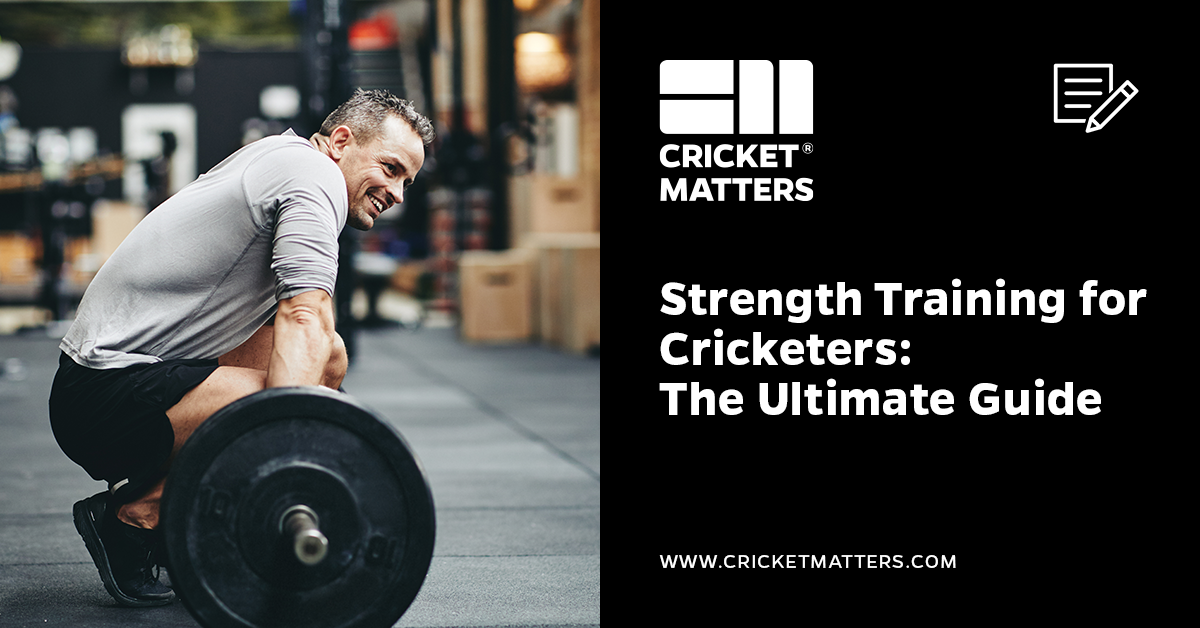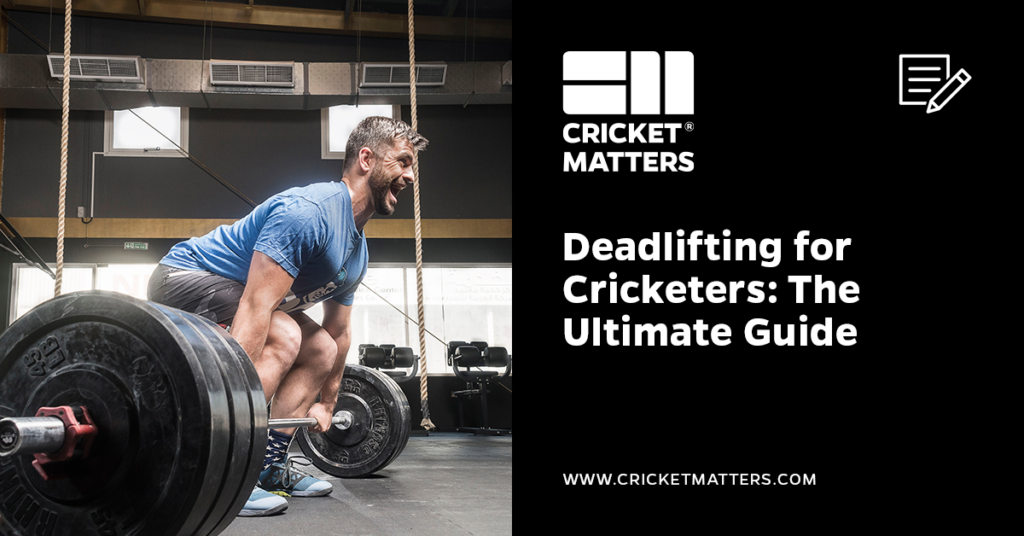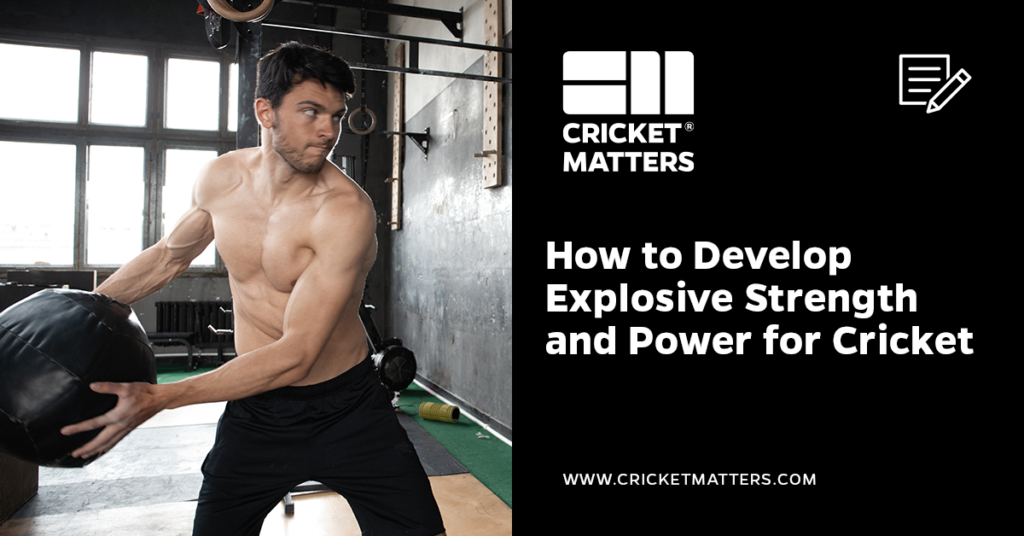
I hope you enjoy reading this blog post.
James Breese, Cricket Matters FounderIf you need my help with your cricket fitness, rehab, or nutrition needs, click here.
This is an in-depth guide based on my personal experience as a fitness professional for cricketers who want to understand the importance of strength training for cricket and how to approach it.
This is our approach to strength training at Cricket Matters, and we hope it helps you with your game.
Let’s dive in.
Table of Contents
Introduction
People can, and have, played cricket to the highest level without lifting a single weight in the gym.
But strength training— everything from pull-ups and deadlifts to focused muscular endurance work—is fundamental to becoming a well-rounded cricketing athlete with a long, injury-free career.
The Cricket Matters philosophy of strength training is simple.
We want to build functional strength that translates to improved health and performance.
A proper strength program will help you develop into a more durable, more powerful, and more efficient cricketer—a cricketer capable of moving well for many hours, sometimes day after day, that can perform and recover quickly.
As with any well-structured training program, a cricket-oriented strength regimen starts general and sharpens into something more specific over time.
Ideally, it should be geared toward the unique physical demands of your speciality, e.g. fast bowling.
We can’t cover all cricketing aspects in this article, so we’re going to focus on general strength standards and exercises that we feel all cricketers should be able to achieve, irrespective of their discipline.
Strength training is not something to be forgotten about during your cricket training plans but it’s not something that should dominate them either.
You need to find a balance and combine both for optimal effect.
Speed Is a Form of Strength

An athlete’s speed depends to a large extent on their power (the rate that strength is applied).
To move faster, you need to be able to create higher forces (strength) in the locomotive muscles, and you need to be able to do so more quickly.
When a professional sprinter steps to the line of a 100-meter sprint, their muscles and tendons tense with incredible potential energy.
When the gun goes off, their brain communicates a nearly instantaneous signal to those muscles to contract with tremendous power, propelling them off the blocks and into an elite level of performance.
In this example, we can identify the sprinter’s power in two capacities: The contractile force of their muscles and the neuromuscular efficiency of their central and peripheral nervous systems as they command function from those muscles at incredible rates.
That is strength.
While a sprinter’s display of power is obvious, the same principles apply to the endurance athlete.
The Components that Make Up Athletic Cricketers
Any cricketer interested in maximizing their performance should look first at what component parts make up their individual discipline. In general, we look at the following:
- Aerobic Efficiency: This is the metabolic ability of the body to utilize fat as fuel while performing.
- Speed: This is a form of strength and power.
- Muscular Endurance: This is the ability of the muscles to produce a higher work output over longer durations in a predominantly aerobic state.
- Form and Technique: This is the cricketer’s proficiency at a given skill set, which supports their ability to avoid injury and maintain good form despite accumulating fatigue. Yet another form of strength.
We examine these components and decide how to train each one, first individually and then in combination, implementing increasingly complex, specific workouts depending on whether it’s pre-season, off-season or mid-season.
These are the four elements I always look at whilst working with any cricketer, wanting to get stronger.
The first three I can help improve, the fourth, form and technique, is one of the hardest things to correct and should be a joint effort between each athlete and their coach(es).
Gym Strong Isn’t Cricket Strong

For many cricketers, the term strength training conjures images of muscle-bound gym bros grunting out bicep curls in front of a mirror or chasing a new one-rep max for a deadlift. Erase that from your mind, because that is not what strength training should look like for a cricketers.
A cricketer needs to develop sport-specific functional strength for their given activity, not bulk they’ll have to haul around the field all day.
They can’t afford to gain strength at the expense of adding appreciable muscle mass.
Strength training for cricket has two primary aims.
First, to unlock your full athletic performance potential. Second, to reduce the likelihood of injuries.
The goal is not to become stronger in the gym. You will lift weights to address deficiencies in your overall general strength but, once you have accomplished that, it will benefit your performance to transition to more sport-specific strength work.
In cricket, weightlifting should never be an end unto itself.
Strength Programming for Cricketers

Because of the differences between disciplines (batting, bowling, etc.) and the need for individuality, it is not possible to provide a one-size-fits-all training plan.
The idea here is to explain how to implement basic principles that allow you to develop a workable plan, and then start the conversation about strength training for endurance athletes.
Taking the four components we discussed above (aerobic efficiency, speed, muscular endurance [ME], and form and technique), we’re going to focus on just the speed and ME parts of the training load and assume solid foundations in both the other two.
The best training plans are always the plans that get done.
A less-than-ideal training plan will give you better results than the best plan in the world, which never gets done. Often, training plans are presented as a black-and-white affair.
Do this or do that to get x result.
However, experience shows that the human body is far more complex and we must often operate in shades of grey.
That’s why it’s more important to understand the principles of strength training for cricket and not get into the specifics of individual exercises then formulate a plan of attack, keeping in mind your own limitations.
Further Reading
Outlining the Plan

That being said, it’s important to keep your expectations in line with your commitment. Success at reaching your goals will breed enthusiasm to continue, ensuring future success.
There are three things you need to do to establish a solid base plan:
Be Realistic – Setting goals that are in line with your past training history and your available time is important. Biting off more than you can chew will at best lead to frustration, at worse cause you serious injury.
Have a Goal – Any goal, just choose one. Not having a goal is like going to the airport without a destination in mind. This sounds so basic, but it’s surprising how few people have specific targets for their endurance events other than just to complete it.
Commit – The best plan in the world will not be worth the paper it is written on if you don’t do the work. Get prepared to spend hours and hours, probably alone, doing repetitive, unglamorous work. Embrace the process or the result will elude you.
You need to honestly evaluate where you are now and how much time you can commit to training.
Playing cricket often means you don’t have much spare time, and one of the most common mistakes we see cricketers make is to over commit their training hours.
Make a tally of the average hours per week you spent over the past year in the nets, playing, traveling, and spending time with friends and family.
The remaining hours are what you have available to train.
Use this as a guide and a reality check so you know the absolute upper limit of how much time you can train.
When you’re excited about starting a new training plan with new goals, there is a tendency to jump into training too aggressively.
Most of us tend to overestimate our own abilities. The best rule of thumb for those starting a new plan is to start easy and gradually progress.
It’s why we organize our training plans into three distinct periods: Off-season, pre-season base, and mid-season.
Strength Training for Cricketers Off-Season

The off-season period is a preconditioning phase to prepare people for the specific demands of the pre-season period leading towards the season and recover from the trauma of the previous season. Cricket takes a toll on your body.
It’s a hard sport.
It is extremely important for those without a strong background of strength training and those who are new or are returning to training following a lengthy lay off to spend time in this period.
How much time depends on the cricketer’s ability – two to four weeks for advanced individuals is enough but most cricketers who are new to strength training could be looking at a far longer period (12 to 24 weeks is not unheard of).
In an ideal world, and being extremely conservative, I like to set annual strength training targets.
For most cricketers, a total of 300 annual training hours is a good realistic goal. This is approximately six hours of strength training a week.
How we split this time between strength, cardio and mobility work depends on the athlete’s current training levels as determined by some general strength assessments.
Strength Standards
In general, when it comes to strength training in the off-season period for cricketers, I’m looking for the following general strength standards:
- Deadlift: 5 Reps. Men @ 1.5 x Bodyweight. Women @ 1.25 x Bodyweight.
- Double Kettlebell Front Squat: 50 percent bodyweight for 25 reps (e.g 2 x 20kg kettlebells if you weight 80kg)
- Straight Arm Plank: 2 Minutes
- Turkish Get Up: 5 reps each side. Men: 24 – 28kg. Women: 12 – 16kg
If none of these standards can be achieved, then this is where most of our time is going to be spent developing a strong base for your cricketing activities.
Strength training is an essential supplement to an cricketer’s training because strengthening muscles and joints can improve performance and decrease injury risk.
If you want to perform at your full potential, you need to take a comprehensive approach to training, which almost always starts with strength work.
The reason?
Strong muscles don’t need to expend as much energy to hit a certain pace.
For people who can’t achieve the standards above, assuming you have six hours a week to train during the transition period, working towards the goal of 300 total hours per year, I would split the training time up into four hours of strength work and two hours of endurance work.
For people who can achieve the standards, I would adjust it accordingly to three hours of strength work and three hours of endurance work.
Most people will automatically fall into the off-season period of training, and some may spend a lot of time here, more than they would like to.
The key is planning for the long haul.
The more time you spend trying to reach and maintain these standards, the more it will pay off as you’ll be able to spend more time playing the sport you love—cricket.
A typical off-season period strength workout would cover all fundamental human movements, irrespective of ability, which are:
- Locomotion
- Push
- Pull
- Hinge
- Squat
- Rotate
- Anti-Rotate
This period will prepare the body to train specifically for your chosen sport – we want to make it robust, almost bulletproof, to handle the work you plan to do.
Sample Off-Season Strength Workout
Here’s a sample workout for a more advanced individual during the off-season period:
A) Trapbar Deadlift: 5 sets, 70% max x 8 reps
B) Kettlebell Front Squat: 5 sets, 70% max x 8 reps
C1) Push Ups: 2 sets, 10-12 reps, 70% effort
C2) Pull Ups: 2 sets, 3-5 reps, 70% effort
D) Turkish Get Ups: 5/5 reps, 70% effort
E) Core Work
Simple, easy to execute, not rocket science.
This workout covers all human movements and develops muscular endurance. We don’t need to be taxing the body at this stage.
This is a return to work type training scenario. Harder work will come later.
Strength Training for Cricketers Pre-Season

Strength training methods share a great deal in common, but how you approach the strength aspect really depends on how much cricket you’re playing.
The fact of the matter is, 80% of your time needs to spent training for the skills of cricket.
That’s one of the simplest, easiest, and fastest ways to improve at cricket.
The purpose of the pre-season period is to increase your work capacity and improve fatigue resistance.
You build this fitness base so that you can handle more work and eventually more intense work, which prepares you for the matches themselves.
You’ll achieve this by using a simple progression principle of adding more volume over time.
It’s going to be gradual and continuous (no breaks).
A proper cricket training plan requires a focused plan for months on end. There are no shortcuts.
It’s all about developing muscular endurance and your aerobic base.
Without this base, you won’t recover fast enough and the matches themselves will leave you in a crippled mess the day after.
Just look at most club cricketers who play on the opening game of the season, then who can barely walk for weeks or even months after!
During much of the pre-season period you will likely be a little too tired to feel like you’re performing at your best. That’s ok. It’s a volume thing.
Expect to have slightly heavy legs some days. That’s part of the plan.
So, assuming once again you have six hours a week to train during the base period, I will (usually) break the training time up into two to three hours of strength work and three to four hours of endurance work.
Ideally, you’d complete three strength training sessions per week and at least three to four hours of endurance work, but this is dictated by your life outside of training and skills practice at nets.
Not everyone has seven hours of free time available to them each week.
As a bare minimum, pre-season strength training needs to happen twice a week.
As a rule of thumb, pre-season strength work follows the pattern of:
- Max Strength
- Strength Endurance
- Muscular Endurance
And in that order, all in one workout, for all seven human movements.
We don’t want to overload the system with too much max strength work, as it will detract from the main endurance workouts themselves, but we still need an element of it alongside strength endurance and muscular endurance.
Muscular endurance work will pay a big part as I’m looking to fatigue the muscles used primarily by the athlete somewhat ahead of the easy aerobic days.
I want the athlete to move whilst under controlled fatigue and to adapt to this low-level stress.
Core strength will also play an integral role during the pre-season period.
Your core plays a critical role in cricket – everything starts from the core.
It stabilizes the pelvis, spine, and shoulders so that the arms and legs can perform their propulsive functions most effectively.
If the core is not able to transfer energy effectively from upper to lower body, you will lose power, meaning you use more energy and ultimately being less efficient – a recipe for disaster for cricketer who wants to be as powerful in his bowling action, or stroke play as possible.
Sample Pre-Season Strength Workout
Here’s what a workout would look like for a cricketer in the pre-season period:
A) Trapbar Deadlift: 3 sets, 5 reps
B) Rear Foot Elevated Split Squats (RFESS): 3 sets, 8/8 reps
C1) Dumbell Bench: 2 sets, 12-15 reps
C2) TRX Rows: 2 sets, 12-15 reps, 70% effort
C3) Russian Box Step Ups (Weighted): 2 sets, 12/12 reps
D) Turkish Get Ups: 15 minutes, AMRAP
E) Core Work: 5 minutes, hard
Core and legs are a big feature of this workout. With the RFESS and Russian Step Ups, we are looking to fatigue the legs ahead of some of their aerobic work.
That’s the plan, controlled fatigue and structure. Remember this is the pre-season period, not mid-season.
Slight fatigue is to be expected and desired.
Strength Training for Cricketers Mid-Season

Cricket is such a unique sport as it puts so much stress on the body.
Whether you’re a seasoned pro, or a regular club cricketer, the golden rule here is to treat your strength work as active recovery.
You need to do some but the intensity should be significantly reduced. You need to walk out of the gym feeling as fresh as a daisy, not sore as a beast.
This will be paired with easier, recovery-based aerobic endurance workouts.
The workouts themselves will follow a similar format of adhering to the seven fundamental human movements and working in the strength endurance and muscular endurance ranges.
Max power is NOT what we’re looking for right now.
If anything, an even bigger emphasis should be placed on stretching, rolling, massage, and even swimming (not discussed previously, but still very important in all phases).
Be proactive with this, even doing it every day. More is better with this type of work, but less with the strength work.
Sample Mid-Season Strength Workout
This is a sample workout for a cricketer who is mid-season:
Mixed Modal Aerobic: 30 Min AMRAP (70% Effort)
A1) Deadlift: 5 reps.
A2) Military Press: 5 reps
A3) Turkish Get Up: 1/1 reps
A4) Concept2 Rower: 20 calories.
Repeat. No Rest.
Final Thoughts: Strength Training for Cricketers

While strength training is unique to your specific disicipline within the game, it’s important to follow the general guidelines outlined above.
Having a solid base of strength is fundamental for long-term, injury-free training and improved performance; however, when you transition into pre-season training, 80% of your work needs to be playing cricket.
Progression of overload and volume is one of the most important elements to consider here, and not to go too hard or too fast.
No one can tell you what an appropriate amount of time is to spend in the off-season or pre-season periods but, from experience, most people need to spend more time than they think.
I love strength work.
I also love endurance work for cricketers.
Combine the two and, in my opinion, you have a healthy recipe for high-performing cricketing athletes.
Further Reading
FAQs
How Do You Build Strength in Cricket?
Building strength in cricket involves a combination of resistance training and cricket-specific exercises. Weightlifting exercises like squats, deadlifts, and bench presses build overall strength, while plyometric exercises improve power and explosiveness. Tailoring the workout to focus on cricket-specific movements can also help in building functional strength for the sport.
What Exercises Increase Hitting Power in Cricket?
To increase hitting power, focus on exercises that build core and upper body strength, such as rotational exercises, medicine ball throws, and resistance band workouts. Leg strength is also crucial, so include squats and lunges in your routine. These exercises contribute to the overall power and stability required for effective hitting.
Do You Need Strength to Play Cricket?
Yes, strength is a key component for cricket. It aids in batting, bowling, and fielding by enhancing power, reducing the risk of injury, and improving overall athleticism. Strength training should be an integral part of a cricketer’s training regimen to ensure peak performance on the field.
How Often Should Cricketers Engage in Strength Training?
Cricketers should integrate strength training 2-3 times per week. It’s crucial to balance this with skill training and ensure adequate recovery time between strength sessions.
Specific Strength Training Routines for Bowlers vs. Batsmen?
Bowlers may focus more on lower body and core strength to aid in bowling, while batsmen might emphasize upper body and core strength for batting power. Both should maintain overall balanced strength training.
What’s the Role of Core Strength in Cricket?
Core strength is vital for stability, power transfer, and injury prevention. It enhances batting, bowling, and fielding performance by providing a strong base for all movements.
Can Strength Training Help with Injury Prevention in Cricket?
Yes, regular strength training strengthens muscles and joints, reducing the risk of common cricket injuries, particularly in the lower back and shoulders.
Starting Strength Training for Young Cricketers?
Young cricketers should begin with bodyweight exercises, focusing on technique. Gradually, they can incorporate light weights under supervision, prioritizing proper form over heavy lifting. The goal with young cricketers is to just keep them playing a variety of sports for their overall development.



